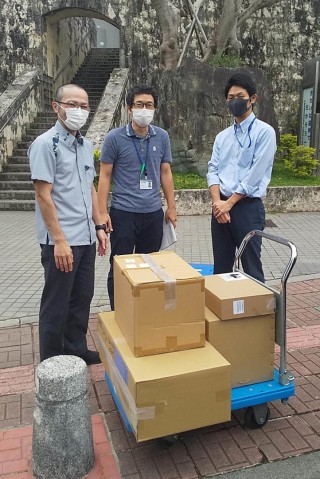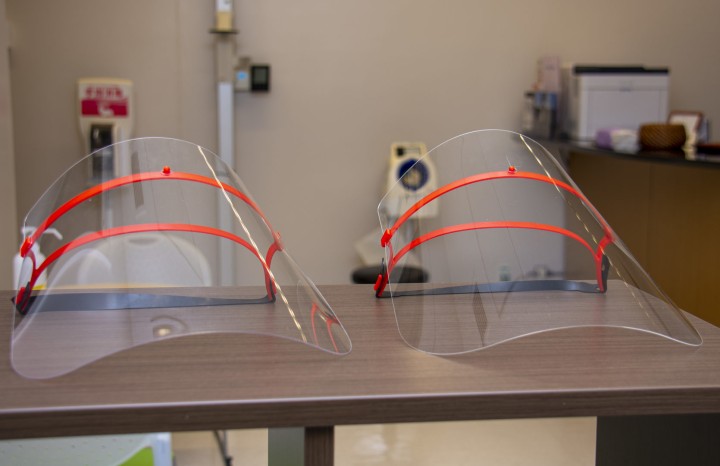Research technicians Micheal Grunwald and Kazumi Toda-Peters and Junior Research Fellow Paul Hsieh-Fu Tsai worked under the guidance of OIST Industrial Physician Dr. Tomoari Mori to 3D print face shields for health care workers in Okinawa.
Updated April 21, 2020
On April 21, 2020, the project team donated its first 400 face shields to the Okinawa Prefectural Government.
April 17, 2020
An OIST research team from the Mathematics, Mechanics, and Materials Unit and the Micro/Bio/Nanofluidics Unit has produced 3D printed face shields that can effectively block coronavirus droplets and aerosols, which is especially important for frontline medical professionals. Research technicians Michael Grunwald and Kazumi Toda-Peters and junior research fellow Paul Hsieh-Fu Tsai collaborated to redesign and print the face shields under the guidance of Dr. Tomoari Mori from the OIST Health Clinic. They are now producing hundreds of face shields that will soon be ready for distribution.
“There is increasing evidence that COVID-19 can be spread through the sneezes and coughs of infected people and these micron size droplets and aerosols can infect healthcare workers through the eye,” said Michael. “Face shields are usually put on top of the surgical or N95 masks that healthcare workers wear as an additional protective barrier to combat COVID-19 infection.”
Michael added that over the last two months, the global 3D printing community has been hard at work creating and sharing designs to help combat the COVID-19 pandemic. “At OIST, we modified a design from the 3D printing company Prusa to minimize the material and time needed to print the headband, as well as to accommodate the laser-cut face shield material that we could source here in Japan.”
One point that was emphasized was the importance of not touching the front of the face shields at any time after putting it on.
“After a face shield is used, consider that its entire surface is contaminated,” said Paul. “When removing it, make sure to touch the headband instead of the front shield, disinfect all the surfaces properly and don't forget to wash your hands with soap."
After a meeting with the Okinawa Prefectural Government in early April, the research team has been working hard to fulfill their request for 800 face shields for distribution to hospitals all around Okinawa.
This project continues to receive a lot of help from the OIST community. Professor Izumi Fukunaga from the Sensory and Behavioural Neuroscience Unit shared her newly ordered 3D printer to boost the high throughput capacity. Ph.D. student Ainash Garifullina from the Micro/Bio/Nanofluidics Unit is helping to organize student volunteers for post-treatment and assembly of the face shield. Kieran Deasy from the Engineering Support Section, Ankur Dhar, Ph.D. student from the Quantum Wave Microscopy Unit, and Jeremie Gillet from the Graduate School are helping with the laser cutting of rubber parts and are monitoring the printing process.
The team has also benefited from support from members of other research units who shared their raw printing materials due to the global shortage of 3D printing materials. Jeffery Prine from the Communications and Public Relations Division prepared the DIY illustration to help the healthcare workers assemble the 3D printed parts of the face shields on site. And the Technology Development and Innovation Center helped with acquiring printing material and provided their incubator facilities for the 3D printing.







